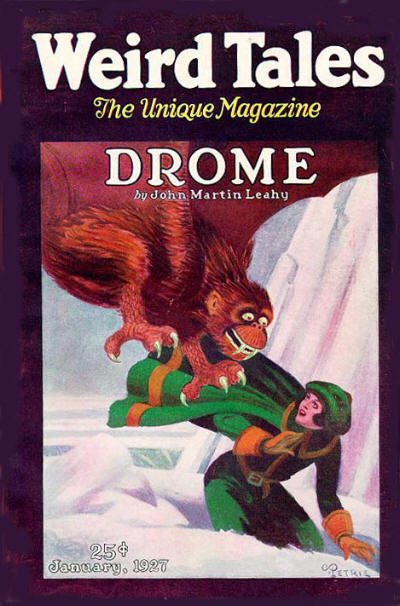 First published by Weird Tales, reprinted by Christine Campbell Thomson, Herbert Asbury, Charles M. Collins, August Derleth, and Barry J. Gillis. Free online.
First published by Weird Tales, reprinted by Christine Campbell Thomson, Herbert Asbury, Charles M. Collins, August Derleth, and Barry J. Gillis. Free online.The impoverished children of New York are disappearing and Thomas F. Malone is on the case. Robert Suydam, who gets younger and more invigorated, comes under suspicion when a child's face is spotted in one of Suydam's basement windows. Malone stops by various properties and finds fleeing foreigners, charnel stench, mysterious instruments, and blood spatters.
Lovecraft wrote of the tale's origin:
"The idea that black magic exists in secret today, or that hellish antique rites still exist in obscurity, is one that I have used and shall use again. When you see my new tale "The Horror at Red Hook", you will see what use I make of the idea in connexion with the gangs of young loafers & herds of evil-looking foreigners that one sees everywhere in New York."
 From our twenty-first-century perspective, the tale's origin is an embarrassment of racism, yet Lovecraft's influence permeates the genre and wider culture. We need to understand where we've come from. Plus, it's too easy to be dismissive of times other than one's own. As Roger Luckhurst points out in his introduction to Oxford University Press's The Classic Horror Stories by H. P. Lovecraft, following the millions devastated by W.W.I and the Spanish flu, western civilization was felt to be on the decline. Moreover, social Darwinism gave racism an intellectual justification, with such prominent proponents as Jack London. Lovecraft likely considered himself an intellectual studying myth and even penning a chemistry textbook.
From our twenty-first-century perspective, the tale's origin is an embarrassment of racism, yet Lovecraft's influence permeates the genre and wider culture. We need to understand where we've come from. Plus, it's too easy to be dismissive of times other than one's own. As Roger Luckhurst points out in his introduction to Oxford University Press's The Classic Horror Stories by H. P. Lovecraft, following the millions devastated by W.W.I and the Spanish flu, western civilization was felt to be on the decline. Moreover, social Darwinism gave racism an intellectual justification, with such prominent proponents as Jack London. Lovecraft likely considered himself an intellectual studying myth and even penning a chemistry textbook.Lovecraft's racism comes from a slightly different place. Tragedy filled his personal life: a father who went insane from syphilis; the loss of the grandfather, his fortune, and displacement from his home so that Lovecraft felt like a wanderer; his mother's insanity; and Lovecraft's own financial instability. No wonder he felt the imminent, inexorable collapse, the encroaching horror that has no respite, no escape. This describes not only Lovecraft's key story elements but also his plot structures. The evil of the foreigner is inextricably linked to the uncaring and amoral gods--rather beings from another plane.
The story opens with the protagonist's madness ("Malone was content to keep unshared the secret of what could reduce a dauntless fighter to a quivering neurotic"--a term that Lovecraft, according to Lockhurst, once used to describe himself), and the opening quote from Arthur Machen discusses evolution:
"It is possible that man may sometimes return on the track of evolution, and it is my belief that an awful lore is not yet dead.”So we witness the typical, inevitable doom of the Lovecraftian tale. His life mirrored civilization, and his fiction mirrored both. While many critics are dismissive of this tale, Lockhurst sets the story in a primary position, and it does appear to illuminate Lovecraft's work.

No comments:
Post a Comment